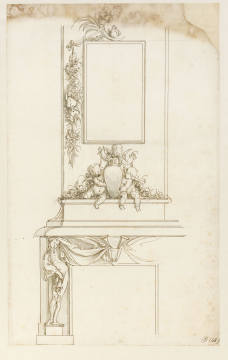
Browse
Reference number
Purpose
Aspect
Scale
Inscribed
Signed and dated
- Undated, but datable 1689-94
Medium and dimensions
Hand
Watermark
Notes
But though the design has affinities with 110/26, it is distinct from the designs for richly sculpted chimney-pieces this and the previous section (4) in several respects. There is no coloured wash; there is a small 'W' insignia in graphite at the centre of the wing motif above the hearth, rather than 'WM' intertwined; there is a single seated dove rather than a pair of sporting birds at the top of the overmantel; the nude herm figure has his head part-covered in drapery as if lifting a veil, an unusual, almost funerary device, untypical of chimney-piece statuary; and there is only a single crown above the cartouche. All these details may point to the design dating shortly after the death of Queen Mary in December 1694, but before William had finally decided to abandon work on the interiors of Hampton Court Palace. As a whole, the design has a mournful character, especially in the pose of the herm figure and the absence of colour. Moreover, it appears to be unfinished. The carved work of the fire surround and overmantel would probably have been in white-painted limewood, perhaps with the intention of imitating the appearance of marble.
Literature
Level
Exhibition history
Sir John Soane's collection includes some 30,000 architectural, design and topographical drawings which is a very important resource for scholars worldwide. His was the first architect’s collection to attempt to preserve the best in design for the architectural profession in the future, and it did so by assembling as exemplars surviving drawings by great Renaissance masters and by the leading architects in Britain in the 17th and 18th centuries and his near contemporaries such as Sir William Chambers, Robert Adam and George Dance the Younger. These drawings sit side by side with 9,000 drawings in Soane’s own hand or those of the pupils in his office, covering his early work as a student, his time in Italy and the drawings produced in the course of his architectural practice from 1780 until the 1830s.
Browse (via the vertical menu to the left) and search results for Drawings include a mixture of Concise catalogue records – drawn from an outline list of the collection – and fuller records where drawings have been catalogued in more detail (an ongoing process).

